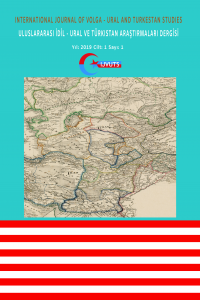
Uluslararası İdil - Ural ve Türkistan Araştırmaları Dergisi
Yazarlar: ["Selahittin TOLKUN"]
Konular:-
Anahtar Kelimeler:Artıklı (küsurlu) sayılar,Belirsiz artıklı (küsurlu) sayılar,Miktar bildiren soru kelimelerinin farklı işlevleri,Klasik Türk şiirinde belirsiz artıklı (küsurlu) sayılar
Özet: In Turkish grammar literature, numeral adjectives are classified as asıl sayı sıfatı “principal numeral adjective”, sıra sayı sıfatı “ordinal adjective”, kesir sayı sıfatı “fraction adjective”, üleştirme sayı sıfatı “distribution adjective” and topluluk sayı sıfatı “community adjective”. This classification is insufficient to define the type of numeral adjectives in structures such as yetmiş küsur yaşında “seventy-odd years old”, yüz kadar insan “about a hundred people” and kırkın üzerinde insan “more than forty people”. Here in this article, we propose the concept of belirsiz artıklı (küsurlu) sayı sıfatı “indefinite residual number adjective” for the type of numeral adjectives found in structures such as “one hundred-odd years old”. Therefore, we call the adjective part here as belirsiz artıklı (küsurlu) sayılar “indefinite residual numbers”. In both historical and contemporary Turkish dialects, different words are used while rounding the relatively unimportant parts after the numbers ten and above (ten, twenty … hundred, thousand, hundred thousand, million, billion, etc.). In today’s Turkey Turkish, the Arabic origin the word “küsur” is used in the written language for this purpose. In the spoken language of Turkey Turkish, in other Turkish dialects and historical Turkish written languages, question words meaning “how many, how much” or adjectives meaning “this much, that much” are used for this purpose. What is most common among them is the interrogative adjective nice “how many, how much” and its allomorphs. These numbers, which we call indefinite residual numbers, essentially take on the task of numeral adjective in Turkish. In the Manas epic, which is almost an encyclopedia for Kyrgyz culture, indefinite residual numbers are expressed with the words neçe and kança, which mean “how many”. In addition, the derivation of indefinite residual numbers with the word bunca by Âşık Ömer, one of the Anatolian-Crimean folk poets, shows us that Turkish needs such an expression and meets this need with Turkish words. In the classical period poetry, the numbers one hundred, one thousand and one hundred thousand carry the expression of multiplicity, extremism and exaggeration, apart from their real meaning. Likewise, when these numbers are converted to indefinite residual numbers (eg, yüz nece yara, bin kaç yıl etc.), the resulting number now conveys a meaning such as “more than most, most of all”. For this reason, it can be said that sometimes indefinite residual numbers are used to increase the degree of exaggeration.